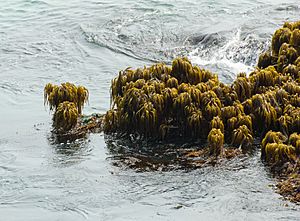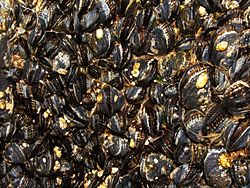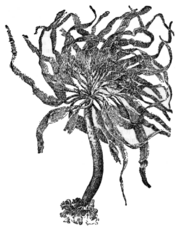Sea palm facts for kids
Quick facts for kids Sea palm |
|
|---|---|
 |
|
| Postelsia palmaeformis growing in its native habitat at low tide | |
| Scientific classification | |
| Genus: |
Postelsia
|
| Species: |
palmaeformis
|
The Postelsia palmaeformis, also known as the sea palm or palm seaweed, is a type of kelp. It belongs to a group called brown algae. You can find sea palms along the western coast of North America, especially on rocky shores where there are always big waves. It's one of the few types of algae that can stay upright and survive out of the water. In fact, it spends most of its life exposed to the air. Sea palms live for about a year. They are edible, but people are asked not to harvest them because they are sensitive to being over-collected.
Contents
History of the Sea Palm
Long before Europeans arrived, the native people of California knew the sea palm as kakgunu-chale. The first scientific description of Postelsia was made in 1852 by Franz Josef Ruprecht. He found a sample near Bodega Bay in California. Ruprecht was a botanist who studied seaweed samples. He published a paper describing several seaweeds, including the sea palm.
The sea palm is often used in science textbooks, like the Campbell–Reece Biology textbook. It's a great example of multicellular protists and a type of brown algae.
What's in a Name?
The name Postelsia honors Alexander Philipov Postels. He was a geologist and artist who worked with Ruprecht. The second part of the name, palmaeformis, means "palm-shaped." This describes how the sea palm looks a lot like a real palm tree.
Ancient Sea Palms: Fossils
Scientists have found fossils that look very much like the sea palm. These fossils were found near Verona, Italy. At first, people thought they were just marks left by animals. But later, they were found to be ancient plants.
In 1926, a botanist named Achille Forti studied these fossils. He realized they were very similar to Postelsia, which is a type of brown algae. He named the fossil Postelsiopsis caput-medusae. This name shows how much the fossil looks like the living sea palm.
The fossil plants had a base (called a holdfast), a stem-like part (stipe), and fronds (blades) that were about 5 to 10 cm long. When the ancient plant was underwater, its fronds would hang down. When the tide went out, they would flop over, just like a living sea palm does today.
How Sea Palms Look and Work

The sea palm has two main forms during its life. The larger, more common form is called the sporophyte. It's the part you see that looks like a mini palm tree. Like all seaweeds, the sporophyte has a thallus. This thallus includes a stem-like stipe with more than 100 leaf-like blades on top. At the bottom, it has a root-like holdfast. The holdfast firmly attaches the sea palm to the rocks.
Sea palms don't have a system like plants do for carrying water and nutrients. The stipe is just a strong, hollow tube. It helps the plant stand up in the air during low tide and survive crashing waves during high tide. The blades have grooves where tiny reproductive cells are held.
The other form of the sea palm is microscopic. It's called the gametophyte and is made of only a few cells. These tiny gametophytes produce sperm and eggs to create new sporophytes.
Sea palms get their energy from the sun through photosynthesis. They use special colors (pigments) like chlorophyll and fucoxanthin to do this. Their cell walls are made of a substance called alginate.
Sea Palm Life Cycle and Growth
Like most brown algae, sea palms have a life cycle that involves two different stages. They are also annual, meaning they live for about one year.
The large sporophyte produces tiny reproductive cells called spores. These spores drop down from the grooves in the blades onto the rocks, mussels, or barnacles below. These spores then grow into small, tiny male and female gametophytes. The male gametophytes produce sperm, and the female gametophytes produce eggs. When the sperm reaches an egg, they join together to form a new sporophyte.
Young sea palms are green, but they turn a golden brown as they get older. They can grow to be about 50 to 75 cm tall.
As a sea palm grows, its stipe gets thicker, much like a tree trunk. Cells just under the outer skin divide quickly, forming growth rings. However, the sea palm's stipe is much more flexible than a tree. This flexibility helps the seaweed bend with the constant waves. A stiff tree would break in such a wavy environment.
The blades of a new sea palm sporophyte start as one or two blades. They grow by splitting down the middle from the base, creating two blades where there was one.
Where Sea Palms Live
Sea palms live on the rocky coasts of western North America. You can find them from Vancouver Island in the north down to the central coast of California. They live in the middle to upper parts of the Intertidal zone. This is the area between high and low tide lines, where waves are very strong.
Strong waves help the sea palm in a few ways. They bring more nutrients to the plant. They also move the blades around, allowing more sunlight to reach the plant for photosynthesis. Plus, the constant waves wash away other organisms that might compete with the sea palm, like the California mussel.

Studies show that sea palms actually grow better when there are mussels around. It's thought that the mussels might protect the tiny developing gametophytes. Another idea is that mussels prevent other algae from growing, which allows sea palms to grow freely once the waves remove the mussels.
When sea palms release their spores, they usually fall only a few meters from the parent plant. This is because spores are often released at low tide and land directly below. Also, the tiny male and female gametophytes need to be close to each other for reproduction to happen. Because of this, sea palms often grow very close together in large groups. Some young sea palms will even grow on competing organisms like mussels or barnacles. When big waves hit, the sea palm's incredibly strong holdfast can rip these competitors from the rocks.
Other Organisms Living on Sea Palms
Several other smaller algae sometimes grow on sea palms. These include two brown algae, Ectocarpus commensalis and Pylaiella gardneri, and two red algae, Microcladia borealis and Porphyra gardneri. Pylaiella gardneri always grows on Postelsia. These algae are called epiphytes. They don't harm the sea palm; they just use the larger alga as a place to grow.
Can You Eat Sea Palms?
The blades (and sometimes the stipes) of Postelsia are used in some dishes, mostly in California. However, Postelsia is a protected species. It is illegal to harvest it in many places. If you cut the blades too low, below the part that grows, the plant cannot reproduce. While sea palms can regrow blades cut higher up, removing blades can still limit how many spores a plant can produce.
At times, Postelsia has been in danger of being over-harvested. It is illegal to collect Postelsia in British Columbia, Washington, and Oregon. In California, it's partly protected: collecting it for fun is illegal, but commercial harvesting (for sale) is allowed. Between 2000 and 2001, about 2 to 3 tons of Postelsia were collected in California. The blades are eaten raw or dried. Dried blades can sell for up to US$45 per pound.
People who harvest Postelsia for sale in California must buy a $100 license. They also pay a fee to the State of California ($24 for every wet ton of algae collected) and must report how much they harvest each month.
One study looked at whether current harvesting methods are sustainable. The results showed that how well the sea palm recovered depended a lot on the season when it was collected.
Images for kids
See also
 In Spanish: Postelsia para niños
In Spanish: Postelsia para niños








